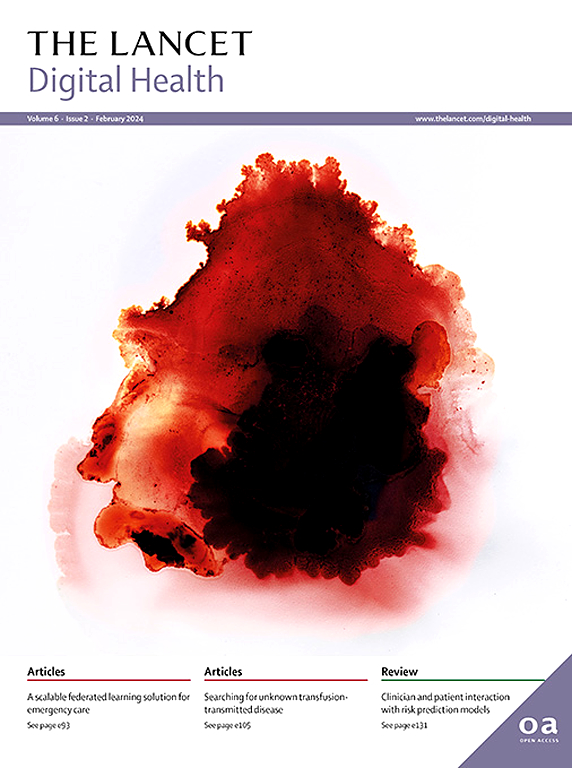Artificial intelligence-enhanced electrocardiography for the identification of a sex-related cardiovascular risk continuum: a retrospective cohort study
IF 23.8
1区 医学
Q1 MEDICAL INFORMATICS
引用次数: 0
Abstract
Background
Females are typically underserved in cardiovascular medicine. The use of sex as a dichotomous variable for risk stratification fails to capture the heterogeneity of risk within each sex. We aimed to develop an artificial intelligence-enhanced electrocardiography (AI-ECG) model to investigate sex-specific cardiovascular risk.
Methods
In this retrospective cohort study, we trained a convolutional neural network to classify sex using the 12-lead electrocardiogram (ECG). The Beth Israel Deaconess Medical Center (BIDMC) secondary care dataset, comprising data from individuals who had clinically indicated ECGs performed in a hospital setting in Boston, MA, USA collected between May, 2000, and March, 2023, was the derivation cohort (1 163 401 ECGs). 50% of this dataset was used for model training, 10% for validation, and 40% for testing. External validation was performed using the UK Biobank cohort, comprising data from volunteers aged 40–69 years at the time of enrolment in 2006–10 (42 386 ECGs). We examined the difference between AI-ECG-predicted sex (continuous) and biological sex (dichotomous), termed sex discordance score.
Findings
AI-ECG accurately identified sex (area under the receiver operating characteristic 0·943 [95% CI 0·942–0·943] for BIDMC and 0·971 [0·969–0·972] for the UK Biobank). In BIDMC outpatients with normal ECGs, an increased sex discordance score was associated with covariate-adjusted increased risk of cardiovascular death in females (hazard ratio [HR] 1·78 [95% CI 1·18–2·70], p=0·006) but not males (1·00 [0·63–1·58], p=0·996). In the UK Biobank cohort, the same pattern was seen (HR 1·33 [95% CI 1·06–1·68] for females, p=0·015; 0·98 [0·80–1·20] for males, p=0·854). Females with a higher sex discordance score were more likely to have future heart failure or myocardial infarction in the BIDMC cohort and had more male cardiac (increased left ventricular mass and chamber volumes) and non-cardiac phenotypes (increased muscle mass and reduced body fat percentage) in both cohorts.
Interpretation
Sex discordance score is a novel AI-ECG biomarker capable of identifying females with disproportionately elevated cardiovascular risk. AI-ECG has the potential to identify female patients who could benefit from enhanced risk factor modification or surveillance.
Funding
British Heart Foundation.
人工智能增强心电图识别与性别相关的心血管风险连续体:一项回顾性队列研究
女性通常在心血管医学方面服务不足。使用性别作为风险分层的二分类变量未能捕捉到每个性别内风险的异质性。我们旨在开发一种人工智能增强的心电图(AI-ECG)模型来研究性别特异性心血管风险。方法在这项回顾性队列研究中,我们训练了一个卷积神经网络,利用12导联心电图(ECG)进行性别分类。贝斯以色列女执事医疗中心(BIDMC)二级保健数据集,包括2000年5月至2023年3月期间在美国马萨诸塞州波士顿一家医院进行临床指征心电图的个人数据,是衍生队列(1 163 401张心电图)。该数据集的50%用于模型训练,10%用于验证,40%用于测试。外部验证使用UK Biobank队列进行,该队列包括2006 - 2010年入组时40-69岁志愿者的数据(43286张心电图)。我们检查了ai - ecg预测的性别(连续)和生物性别(二分)之间的差异,称为性别不一致评分。结果:sai - ecg准确识别性别(BIDMC的受试者工作特征下面积为0.943 [95% CI 0.942 - 0.943], UK Biobank的受试者工作特征下面积为0.971 [95% CI 0.969 - 0.972])。在心电图正常的BIDMC门诊患者中,性别不一致评分增加与女性心血管死亡风险增加相关(危险比[HR] 1.78 [95% CI 1.18 - 2.70], p= 0.006),但与男性无关(危险比[HR] 1.00 [0.63 - 1.58], p= 0.996)。在UK Biobank队列中,同样的模式出现在女性中(HR 1.33 [95% CI 1.06 - 1.68], p= 0.015;男性为0.98[0.80 - 1·20],p= 0.854)。在BIDMC队列中,性别不一致评分较高的女性更有可能出现未来的心力衰竭或心肌梗死,并且在两个队列中都有更多的男性心脏(左心室质量和腔容量增加)和非心脏表型(肌肉质量增加和体脂百分比减少)。性别不一致评分是一种新型的AI-ECG生物标志物,能够识别心血管风险不成比例升高的女性。AI-ECG有可能识别出可以从加强危险因素修改或监测中受益的女性患者。资助英国心脏基金会。
本文章由计算机程序翻译,如有差异,请以英文原文为准。
求助全文
约1分钟内获得全文
求助全文
来源期刊

Lancet Digital Health
Multiple-
CiteScore
41.20
自引率
1.60%
发文量
232
审稿时长
13 weeks
期刊介绍:
The Lancet Digital Health publishes important, innovative, and practice-changing research on any topic connected with digital technology in clinical medicine, public health, and global health.
The journal’s open access content crosses subject boundaries, building bridges between health professionals and researchers.By bringing together the most important advances in this multidisciplinary field,The Lancet Digital Health is the most prominent publishing venue in digital health.
We publish a range of content types including Articles,Review, Comment, and Correspondence, contributing to promoting digital technologies in health practice worldwide.
 求助内容:
求助内容: 应助结果提醒方式:
应助结果提醒方式:


